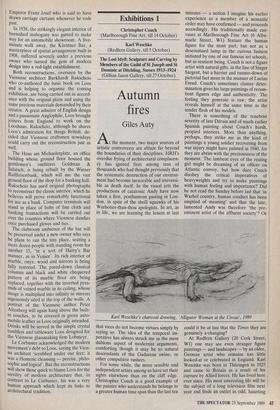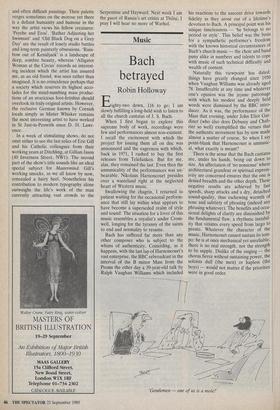Exhibitions 1
Christopher Couch (Marlborough Fine Art, till 14 October) Karl Weschke (Redfern Gallery, till 5 October) The Lost Idyll: Sculpture and Carving by Members of the Guild of St Joseph and St Dominic at Ditchling, Sussex 1913-1924 (Gillian Jason Gallery, till 27 October)
Autumn fires
Giles Auty
At the moment, two major sources of artistic controversy are ablaze far beyond the boundaries of their disciplines. HRH's overdue frying of architectural complacen- cy has ignited fires among tens of thousands who had thought previously that the systematic destruction of our environ- ment had become inexorable and irreversi- ble as death itself. In the visual arts the productions of catatonic Andy have now taken a first, posthumous pasting in Lon- don, in spite of the shrill squawks of his Warholier-than-thou apologists. In art, as in life, we are learning the lesson at last
Karl Weschke's charcoal drawing, 'Alligator Woman at the Circus', 1989 that vices do not become virtues simply by saying so. The idea of the temporal im- perative has always struck me as the most dubious aspect of modernist arguments, comforting though it may be to natural descendants of the Gadarene swine, or other compulsive rushers.
For some while, the more sensible and independent artists among us have set their sights elsewhere than on the cliff edge. Christopher Couch is a good example of the painter who understands he belongs to a greater human time span than the last ten minutes — a notion I imagine his earlier experience as a member of a monastic order may have confirmed — and proceeds accordingly. His traditionally made can- vases at Marlborough Fine Art (6 Albe- marle Street, WI) feature the human figure for the most part, but not as a desensitised lump in the curious fashion initiated by one of our famous art schools, but as sentient being. Couch is not a figure artist with natural gifts, in the line of Singer Sargent, but a harrier and runner-down of pictorial fact more in the manner of Lucian Freud. Couch's sometimes clumsy deter- mination gives his large paintings of recum- bent figures edge and authenticity. The feeling they generate is raw; the artist reveals himself at the same time as the tender flesh of his models.
There is something of the tenebrist severity of late Derain and of much earlier Spanish painting about Couch's harsh, peopled interiors. More than anything, perhaps, they strike me as the kind of paintings a young soldier recovering from war injury might have painted in 1940, for they are abrim with the preciousness of the moment. The lambent eyes of the resting girl might be dreaming of an officer on Atlantic convoy, but how dare Couch disobey the critical imperatives of heavyweights and try to make paintings with human feeling and importance? Did he not read the Sunday before last that 'in Warhol country, human conduct has been emptied of meaning' and that the late, lamented Andy was therefore 'the pre- eminent artist of the affluent society'? Or could it be at last that the Times they are genuinely a-changing?
At Redfern Gallery (20 Cork Street, W1) one may see even stranger figure paintings — and landscapes — by an older, German artist who remains too little looked-at or celebrated in England. Karl Weschke was born in Thuringen in 1925 and came to Britain as a result of his capture by Allied forces. He has lived here ever since. His most interesting life will be the subject of a long television film next year and finds an outlet in odd, haunting and often difficult paintings. Their palette verges sometimes on the morose yet there is a defiant humanity and humour in the way the artist views his fellow creatures: 'Psyche and Eros', 'Bather Adjusting her Swimsuit' and 'Old Black Dog on a Grey Day' are the result of lonely studio battles and long-term painterly obsessions. 'Rain- bow out of Kenidjack' is a landscape of deep, sombre beauty, whereas `Alligator Woman at the Circus' records an interest- ing incident which the artist has assured me, as an old friend, was seen rather than imagined. It is no coincidence perhaps that a society which reserves its highest acco- lades for the mind-numbing mass produc- tions of an avaricious foot-fetishist should overlook its truly original artists. However, the reclusive German known by Cornish locals simply as Mister Whisker remains the most interesting artist to have worked in St Just-in-Penwith since D. H. Lawr- ence.
In a week of stimulating shows, do not omit either to see the last relics of Eric Gill and his Catholic colleagues from their working years at Ditchling, at Gillian Jason (40 Inverness Street, NW1). The second part of the show's title sounds like an ideal special subject for Mastermind. Gill's working smocks, as we all know by now, concealed a hairy heel. Nonetheless his contribution to modern typography alone outweighs the life's work of the man currently attracting vast crowds to the Serpentine and Hayward. Next week I am the guest of Russia's art critics at Tbilisi; I pray I will hear no more of Warhol.



























































 Previous page
Previous page